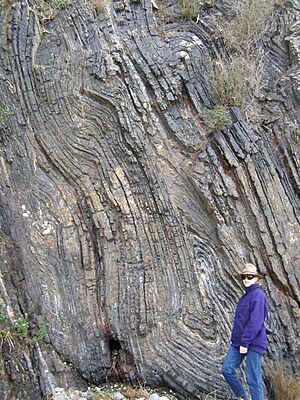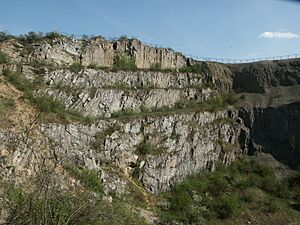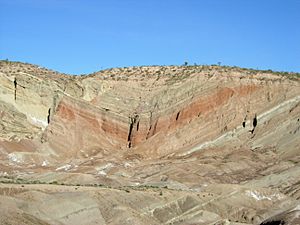Fold (geology) facts for kids
Imagine pushing a rug from both ends – it bunches up, right? That's kind of what happens to rocks deep inside the Earth! When flat layers of rock are squeezed by huge forces, they don't always break. Instead, they bend and curve, forming what geologists call a fold.
This bending process is known as folding. It's a powerful natural event that happens deep within the Earth's crust. These forces often come from plate tectonics, which is the movement of the Earth's giant plates.
Folds can be tiny, even microscopic, or they can be enormous, forming entire mountain ranges! You can find them alone or in long chains. When many folds appear together over a large area, it's called a fold belt. These are common in places where mountains are being built.
Large folds often form where two tectonic plates crash into each other. This intense squeezing causes the rock layers to buckle and bend.
Contents
What are the Parts of a Fold?
Folds have specific parts, just like a bent piece of paper.
- The upward bend, like a hump, is called an anticline.
- The downward bend, like a dip or a valley, is called a syncline.
Imagine a line going along the very top of an anticline; that's the crest line. The sides of a fold, which look like slopes, are known as the limbs. The imaginary line running through the middle of the fold, where the rock layers seem to spread out in opposite directions, is called the axis of fold.
Types of Folds
Scientists classify folds based on how much the rock layers have bent. Here are some main types:
- Symmetrical fold: Both sides (limbs) of the fold have the same steepness. It looks balanced.
- Asymmetrical fold: One side (limb) is steeper than the other, making it look a bit lopsided.
- Overfold: The pressure is so strong that one limb is pushed right over the top of the other.
- Recumbent fold: This is an extreme overfold where both limbs are almost flat and parallel to each other. It looks like the fold has fallen over.
- Overthrust fold: If the squeezing force is incredibly strong, the rock layers can actually break and slide over each other.
How Do Fold Mountains Form?
Many of the world's largest mountain ranges are fold mountains. They form over millions of years through a process involving huge depressions called geosynclines.
1. Sediment Collection: Imagine a large, long basin or trench forming between two tectonic plates. Over long periods, rivers carry sand, silt, and mud into these basins, filling them up. 2. Rock Formation: As more and more sediment piles up, its own weight presses down on the layers below. Over millions of years, this pressure, along with natural cementing, turns the loose sediments into hard sedimentary rocks like sandstone and limestone. 3. Folding and Uplift: When the two tectonic plates continue to push towards each other, the thick layers of sedimentary rock in the geosyncline get squeezed. This intense compression causes the rocks to buckle, bend, and fold upwards. This folding and uplift creates the towering fold mountains we see today.
Famous Fold Mountain Ranges
Many of the world's most impressive mountain ranges are examples of fold mountains. They often form along collision boundarys where plates are pushing together.
- The Himalayas in Asia, home to Mount Everest.
- The Alps in Europe, famous for skiing and beautiful scenery.
- The Andes in South America, the longest continental mountain range in the world.
- The Rocky Mountains in North America, stretching across the western part of the continent.
Images for kids
-
Folds of alternate layers of limestone and chert occur in Greece. The limestone and chert were originally deposited as flat layers on the floor of a deep sea basin. These folds were created by Alpine deformation.
-
Box fold in La Herradura Formation, Morro Solar, Peru
-
Dextral sense shear folds in mylonites within a shear zone, Cap de Creus
See also
 In Spanish: Plegamiento para niños
In Spanish: Plegamiento para niños
















